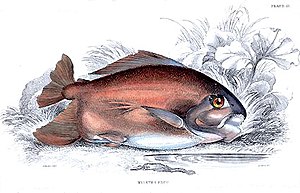Myleus pacu
| Myleus pacu | ||||||||||||
|---|---|---|---|---|---|---|---|---|---|---|---|---|

Myleus pacu , illustration |
||||||||||||
| Systematics | ||||||||||||
|
||||||||||||
| Scientific name | ||||||||||||
| Myleus pacu | ||||||||||||
| ( Jardine , 1841) |
The Myleus pacu belongs to the tetras from South America and is closely related to the piranhas . Despite their relationship, it is mostly a vegetarian fish. Its diet includes berries, seeds, nuts or fruits. Its dentition is particularly characteristic, its teeth are structured similar to those of humans. In newborn fish, the belly of the pacus is red, in adulthood it gradually turns gray to black.
description
The Pacu has a disc-shaped body that is strongly compressed at the sides. Its main characteristic is its dorsal fin , which is up to 31 rays long, and its relatively small adipose fin . This is significantly shorter than the actual distance between the dorsal fin and adipose fin. The dorsal fin lies slightly behind the base of the pelvic fin. The caudal fin is slightly incised. The caudal and dorsal fin are usually marked by a gray border and the belly of the fish is shiny silver. The anal fin is gender specific. Pacus has about 100 scales in the middle row of scales, i. i.e., their body consists of 100 transverse scale rows. This middle row of scales has the shape of a straight side line . In the mouth area, the fish has a keel formed from protruding scales with 28 to 44 teeth. He has molars that are similar to molars , but never incisors . Pacus can reach a total length of 60 to 80 cm and weigh up to ten kilograms.
Gender differences
The gender differences are very clear in the Myleus pacu . The females have a two-lobed anal fin and elongated dorsal fin rays. At spawning time , they also have dark red spots on the side of the body. The males and juveniles, however, have a sickle-shaped anal fin and a dorsal fin without elongated filamentary rays.
Occurrence
The distribution area of the genus extends from Guayana to the Río de la Plata and Rio São Francisco . Most of the time, the Pacu lives near the Amazon . During spawning time they swim up to the upper reaches of large rivers, where they lay their eggs in quiet bays, tributaries or streams.
nutrition
The Myleus pacu is a vegetarian fish, i. that is, he feeds on a pure vegetable diet. Sometimes it also feeds on fruits or flowers that fall from trees. They feed on almost all aquatic plants that are available to them. For the inhabitants of the forests of South America, the pacu is an important food. Considered a delicacy due to its size and tasty meat , it is often caught by locals or offered in seafood restaurants. They are eaten both fresh and smoked . Despite fishing, the Pacu is not yet considered threatened. Pacus are also often kept in large aquariums together with other fish species. They are then given lettuce, spinach or fruit as feed.
Multiplication
In general, the Myleus pacu is oviparous , i.e. H. it reproduces through eggs that lie outside the female body. The reproduction takes place in winter (from November to April). Here, the animals press their back body parts tightly against one another above the ground and then release the eggs. The female puts the anal fin around the anal region of the male. The eggs are then laid on the floor and monitored by the parents for about ten days. Then they start to hatch. Pacus, like all fish, have unlimited growth. However, once the gonads have developed, their growth slows down because they require a great deal of energy to reproduce gametes .
behavior
The Pacu is mostly solitary and herbivorous. Young fish initially live in groups, but soon begin to fight each other. In principle, the Myleus pacu does not attack people. The Pacu has also lived in the rivers of Guinea for 15 years, which meant that it had to change its habits. He began to attack people because otherwise he could no longer find any food. It is now unclear whether the behavior of Pacus has changed due to a new life cycle achieved or due to humans.
Compared to the Pacu of New Guinea
In 1990, 14,000 Pacus were imported to New Guinea, which modified and changed their eating habits and other aspects. The New Guinea pacu, belonging to the genus Piaractus brachypomus , grew larger and its teeth became sharper. It can weigh up to 25 kg and be 88 cm long. The FISHAID project followed the initiative in 1990. The aim of this project was to increase the number of fish in the river as there were few left in the rivers of New Guinea. Due to the increasing number of fish, the inhabitants were able to supply themselves with more food, but this resulted in unexpected consequences in the ecosystem of the surrounding rivers. Initially, the New Guinean Pacu lived on plants, but when these became scarce, he began to eat meat, mostly smaller fish , but also smaller crocodiles . The fish in New Guinea is now known for its aggressiveness. In 2001 Pacus attacked two fishermen, biting their legs and genitals .
literature
- Bernhard Grzimek : Grzimeks animal life (fish I). Kindler Verlag, Zurich 1970, ISBN 3-463-16904-5 , p. 303.
- Günther Sterba: The world's freshwater fish. Weltbild Verlag, Augsburg 1999, ISBN 3-89350-991-7 , pp. 11–16 and 123–124.
- Rizzoli Larousse: Enciclopedia. La Biblioteca del Sapere (= edizione speciale per il Corriere della Sera. ). Quotidiani SPA, 2004.
- Jeremy Wade: River Monster . Documentary, episode 01, season 2. Icon Films production, New Guinea 2011.